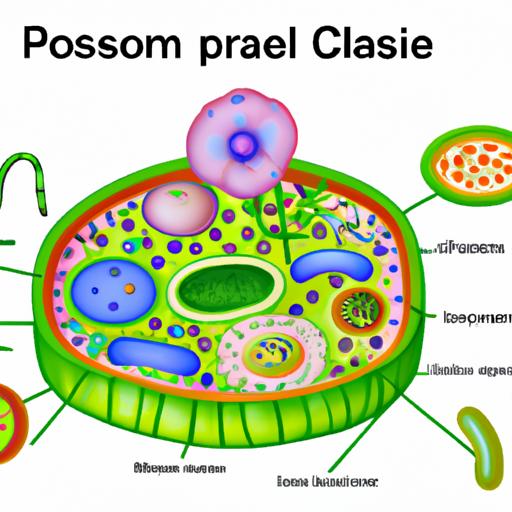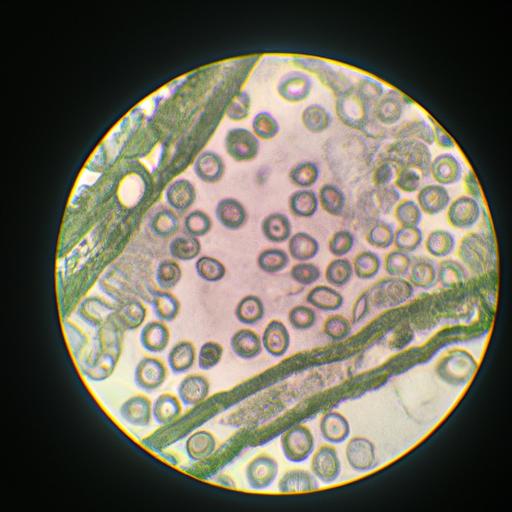Do Plants Have Lysosomes? Unraveling the Secrets of Plant Cell Biology

Introduction
Lysosomes play a vital role in the intricate world of cell biology. These tiny organelles, often referred to as the cell’s recycling centers, hold the key to cellular waste management and maintain overall cell health. But here’s the burning question: do plants have lysosomes? Join me on this fascinating journey as we delve into the depths of plant cell biology to uncover the truth behind the presence of lysosomes in plants.
Lysosomes, known for their ability to break down and recycle various cellular components, are typically associated with animal cells. These tiny, membrane-bound sacs contain a mix of digestive enzymes that efficiently dismantle unwanted materials, such as damaged organelles, proteins, and foreign substances. Their role in maintaining cellular homeostasis and eliminating waste is crucial for the overall health and function of animal cells.
However, when it comes to plant cells, the existence of lysosomes has long been a subject of debate among scientists. While traditional wisdom suggests that plants lack these specialized organelles, recent studies have shed new light on alternative mechanisms employed by plants for cellular degradation. So, let’s embark on this scientific exploration together to uncover the truth behind lysosomes in plant cells.
In the next section, we will take a closer look at the intricate anatomy of plant cells and explore the organelles that make up their unique structure. Join me as we unveil the mysteries of plant cell biology and discover the truth behind the presence of lysosomes in these remarkable organisms.
Plant Cell Anatomy
Overview of Plant Cell Structure
To understand the complexities of plant cell biology, let’s begin with a brief overview of the structure of a typical plant cell. Plant cells, similar to animal cells, are eukaryotic cells, meaning they possess a defined nucleus and membrane-bound organelles. However, there are notable differences that set them apart.
Plant cells are enclosed by a rigid cell wall, composed primarily of cellulose, which provides structural support and protection. This cell wall gives plants their strength and allows them to maintain their shape, unlike animal cells. Additionally, plant cells contain several specialized organelles that contribute to their unique functions and processes.
Introduction to Organelles Present in Plant Cells
Now, let’s turn our attention to the organelles present in plant cells. While plant cells lack conventional lysosomes, they have alternative mechanisms that serve similar functions. One such organelle is the vacuole, a large, fluid-filled sac enclosed by a membrane called the tonoplast.
The vacuole is a multitasking organelle, primarily responsible for maintaining turgor pressure, storing nutrients, regulating pH levels, and participating in cellular degradation. Just as lysosomes in animal cells break down unwanted components, vacuoles in plant cells utilize a combination of enzymes and acidic conditions to degrade and recycle cellular waste.
In addition to vacuoles, plant cells possess other essential organelles, including the nucleus, mitochondria, chloroplasts, endoplasmic reticulum, and Golgi apparatus. Each of these organelles plays a unique role in plant cell function, such as DNA storage and replication, energy production, photosynthesis, protein synthesis, and cellular transport.
As we explore the presence of lysosomes in plant cells, it becomes evident that while traditional lysosomes may not be present, plants have evolved alternative mechanisms to perform similar functions. In the next section, we will delve deeper into the world of lysosomes in animal cells to gain a better understanding of their significance and role. Stay tuned as we unravel the mysteries of cellular degradation in plants.
Note: Remember to maintain a friendly and engaging tone throughout the article, using rhetorical questions and metaphors to captivate the reader’s attention.
Lysosomes in Animal Cells
Lysosomes are a prominent feature of animal cells, playing a pivotal role in their metabolism and overall cellular function. Let’s dive into a detailed description of these fascinating organelles and explore their essential functions within animal cells.
Lysosome Structure and Composition
Lysosomes are spherical organelles enclosed by a single membrane, separating their internal environment from the rest of the cell. Within this membrane, a variety of hydrolytic enzymes are present. These enzymes, including proteases, lipases, and nucleases, are responsible for the breakdown of various biological macromolecules.
Functions of Lysosomes
Lysosomes function as the cell’s recycling centers, participating in a range of crucial processes within animal cells:
1. Intracellular Digestion
Lysosomes carry out intracellular digestion by fusing with endosomes or phagosomes, forming digestive compartments known as phagolysosomes or endolysosomes. Through this fusion, lysosomal enzymes break down engulfed materials, such as bacteria, viruses, or cellular debris, into simpler molecules that can be recycled or expelled from the cell.
2. Autophagy
Autophagy, a process essential for maintaining cellular homeostasis, involves the degradation of damaged or obsolete cellular components. During autophagy, cytoplasmic material is enclosed within double-membrane vesicles called autophagosomes, which subsequently fuse with lysosomes. The lysosomal enzymes then dismantle the enclosed material, allowing for recycling and energy generation.
3. Cellular Waste Management
Lysosomes also play a critical role in removing unwanted or malfunctioning organelles, ensuring the overall health and functionality of animal cells. Through a process known as microautophagy, lysosomes directly engulf and degrade small portions of the cytoplasm or organelles.
The Role of Lysosomes in Animal Cell Metabolism
Lysosomes contribute to cellular metabolism by breaking down complex molecules into simpler compounds that can be utilized by the cell. The enzymes within lysosomes aid in the breakdown of proteins, lipids, carbohydrates, and nucleic acids, releasing building blocks that can be used for energy production or biosynthesis.
In the next section, we will explore the presence of lysosomes in plant cells, comparing and contrasting their functions with those found in animal cells. Get ready to unravel the mysteries of plant cell biology and discover the unique mechanisms employed by plants for cellular degradation.
Lysosomes in Plant Cells
Comparison of Lysosomes in Animal and Plant Cells
To understand the presence of lysosomes in plant cells, it is essential to compare them with their counterparts in animal cells. In animal cells, lysosomes are well-defined structures containing a variety of hydrolytic enzymes responsible for breaking down cellular waste. These enzymes function optimally in the acidic environment within lysosomes. However, plant cells pose a unique challenge as they maintain a more neutral pH, which is not conducive to the typical functioning of lysosomal enzymes.
Furthermore, the presence of lysosome-associated membrane proteins (LAMPs), which are integral to lysosomal function in animal cells, is relatively scarce in plant cells. LAMPs play a crucial role in maintaining the structural integrity and dynamic nature of lysosomes. Their scarcity in plant cells further raises doubts about the existence of traditional lysosomes in these organisms.
Controversies Surrounding the Presence of Lysosomes in Plant Cells
The question of whether plants have lysosomes has stirred up considerable controversy among researchers. Traditional studies have failed to provide concrete evidence of lysosomes in plant cells, primarily due to the absence of typical lysosomal features, such as acidic pH and abundant LAMPs. These findings suggest that plants might have alternative mechanisms to carry out similar functions without the presence of lysosomes.
Some scientists argue that plants possess lysosome-like structures called “vacuolar compartments.” These vacuoles, commonly found in plant cells, can perform functions similar to lysosomes, albeit with some variations. They act as storage compartments and participate in the degradation of cellular waste through enzymatic activities. While these vacuolar compartments may not be true lysosomes, they fulfill similar roles, ensuring proper cellular waste management in plant cells.
In the next section, we will explore the alternative organelles present in plant cells that serve similar functions to lysosomes, shedding further light on the intriguing world of plant cell biology. Join me as we uncover the remarkable adaptations plants have developed to overcome the absence of conventional lysosomes.
Alternative Organelles in Plant Cells
In the quest to understand the absence of lysosomes in plant cells, scientists have discovered fascinating alternative mechanisms that serve similar functions. While lysosomes may be absent, plant cells are not left defenseless when it comes to cellular degradation. Let’s explore the alternative organelles that come into play in plant cells and shed light on their remarkable capabilities.
h3: Introduction to Alternative Organelles
Plant cells rely on alternative organelles to carry out cellular degradation processes that are similar to the functions performed by lysosomes in animal cells. One such organelle that takes center stage in this role is the vacuole. Although primarily recognized for its role in storing water, nutrients, and pigments, the vacuole is also a key player in cellular degradation within plant cells.
h4: Vacuoles and their Role in Plant Cell Degradation
Plant vacuoles, often referred to as “plant lysosomes,” exhibit features and functions reminiscent of the lysosomes found in animal cells. These large, membrane-bound sacs act as storage depots for various substances but also play a pivotal role in the breakdown of cellular waste. Within the vacuole, a range of enzymes is responsible for degrading unwanted proteins, damaged organelles, and other cellular debris.
The vacuole’s acidic interior creates an environment conducive to enzymatic activity, ensuring efficient degradation and recycling of cellular components. Additionally, the vacuole’s ability to maintain turgor pressure within plant cells allows for optimal cell functioning and structural support.
While the vacuole may not be an exact replica of lysosomes, its multifaceted role in plant cell degradation showcases the resourcefulness of nature. Plant cells have evolved alternative mechanisms, harnessing the power of the vacuole to efficiently manage cellular waste and maintain optimal cellular health.
In the next section, we will conclude our exploration by summarizing the main points discussed and reflecting on the presence of lysosomes in plant cells. Join me as we wrap up this intriguing journey and gain a deeper understanding of the fascinating world of plant cell biology.
Conclusion
After a deep dive into the world of plant cell biology, we have come to a clearer understanding of the presence (or absence) of lysosomes in these remarkable organisms. While the scientific consensus currently leans towards the absence of traditional lysosomes in plant cells, it is crucial to acknowledge the alternative mechanisms employed by plants for cellular degradation.
Plants have evolved unique adaptations to meet their cellular waste management needs. Vacuoles, large membrane-bound sacs found in plant cells, act as versatile storage units and play a crucial role in cellular degradation. These vacuoles contain a variety of enzymes that aid in breaking down and recycling cellular components, similar to the functions of lysosomes in animal cells. In this sense, vacuoles serve as the plant cell’s recycling centers, ensuring the removal of unwanted materials and the maintenance of cellular homeostasis.
While the absence of traditional lysosomes in plant cells may seem surprising, it highlights the incredible diversity and adaptability of life forms on our planet. Plants have developed unique strategies to thrive in their environment, and their alternative mechanisms for cellular degradation showcase their ingenuity.
As we continue to unravel the mysteries of plant cell biology, it is essential to approach scientific knowledge with an open mind. Ongoing research and technological advancements may shed further light on the presence of lysosome-like structures or undiscovered organelles in plant cells. The scientific community eagerly awaits new insights that may challenge or expand our current understanding.
In conclusion, while traditional lysosomes may not be a part of the plant cell architecture, plants have evolved their own sophisticated mechanisms to carry out cellular degradation and maintain their overall health. The fascinating world of plant cell biology continues to captivate scientists and nature enthusiasts alike, as we strive to uncover the secrets of these incredible organisms.
So, the next time you marvel at a blooming flower or a towering tree, remember that beneath their beauty lies a complex cellular world, where plants have ingeniously adapted to thrive without the traditional lysosomes found in animal cells. The wonders of plant biology are boundless, and there is much more to explore and understand.
Conclusion: So above is the Do Plants Have Lysosomes? Unraveling the Secrets of Plant Cell Biology article. Hopefully with this article you can help you in life, always follow and read our good articles on the website: plants.123didulich.com



